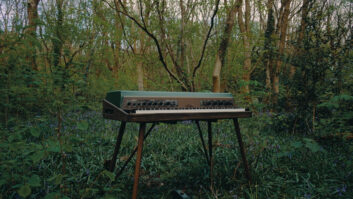
The high-profile owners of new £20 million penthouse suites at Battersea Power Station—including Sting and Bear Grylls—have been playing second fiddle to a breeding pair of peregrine falcons.
As part of the Grade II-listed building’s £9 billion regeneration project it was stipulated that a new tower had to be erected to replace the original iconic chimneys, the natural habitat of these birds of prey who have been nesting there for 13 years.
Martin Audio long-term partners Rossco was introduced to the project by Simon Woodward of Polar Bear Live at the inception. As an acoustics consultant and event technical provider, MD Ross Sharples has provided audio support since the original confirmation of the Malaysian Consortium bid back in 2013.
“We are fully qualified when considering the impact of sound on the environment,” he said. And this includes the falcons’ wellbeing, where a 1-min calibrated measurement mic has been placed near the nesting platform to monitor any sound disturbance.
But as Europe’s biggest urban development project neared fruition, operators, the Battersea Power Station Development Company, started to introduce events on the jetty overlooking the Thames last summer. An over-the-top line array was brought in by another service provider with the result that the sound traveled across the Thames to Pimlico and beyond.
“Everyone complained and that jeopardized the license,” reports Sharples. “So this year they brought Simon back and he commissioned us to achieve more acceptable levels.” The Rossco MD had no hesitation in turning to his faithful Martin Audio inventory, specifying a distributed time-aligned system along the deck. “I have always loved the ethos and heritage of Martin Audio,” he qualifies.
The coverage distance needed to be half of the 100m long (10m wide) jetty, with a 5m x 3m hi-res LED screen at one end and a FOH platform set 45m back at the rear. Rossco set a nominal 90dB(A) sound threshold for the wide range of cinematic, theatrical and music productions that would take place.
“While the local council [London Borough of Wandsworth] didn’t impose specific criteria they simply said they couldn’t be exposed to that level of complaint again. As I didn’t want to set hard limiters a subjective common-sense approach was called for.”
Taking no chances, Rossco installed a calibrated measurement meter which records audio levels as a WAV file. “This is stored as data, so as regards sound levels we can access remotely and ensure its within permissible limits,” he says.
Unusually, he turned to older Martin Audio technology to fulfil his objectives, opting for a pair of Wavefront W2s, stage left and right, with seven pairs of miniature W0.5 running back on either side, spaced three meters apart. “All are individually time-aligned and EQ’d, pointing inwards and downwards to maintain a stereo image,” he said. “With a distributed system we knew we could minimize spillage.”
However, the bigger conundrum was with the subs. “We needed rear rejection as LF would be travelling backwards towards the falcons’ nest, and that was the primary concern. A cardioid array would have spoiled the aesthetic.” Their solution was a pair of SXC118, into which the W2’s are pole-mounted. “We didn’t need big subs and knew about the excellent rear rejection qualities of this speaker.”
In fact the SXC118 features an 18” forward facing driver and a 14” rear facing driver, each driven independently by separate amplifier channels and DSP. Offering a cardioid dispersion pattern, it combines high output capability with 28dB rear rejection at 75Hz.
Meanwhile, Ross Sharples confirmed that Rossco’s older Wavefront stock had been maintained immaculately and performed exceptionally. “In fact visiting sound engineers were saying the sound produced by the Wavefronts was the best they had heard.”
It has provided the perfect listening environment for the audiences of around 120, lounging in the deckchairs set in pairs along the boardwalk for the duration of the summer season.
Summing up, Ross Sharples states, “The objective was to redeem the situation on the jetty following last year’s catastrophe with a totally controlled sound that you can now barely hear across on the other side of the Thames.
“At the same time we’ve done our bit to help protect the falcons … it’s special!”
For more information: https://martin-audio.com










